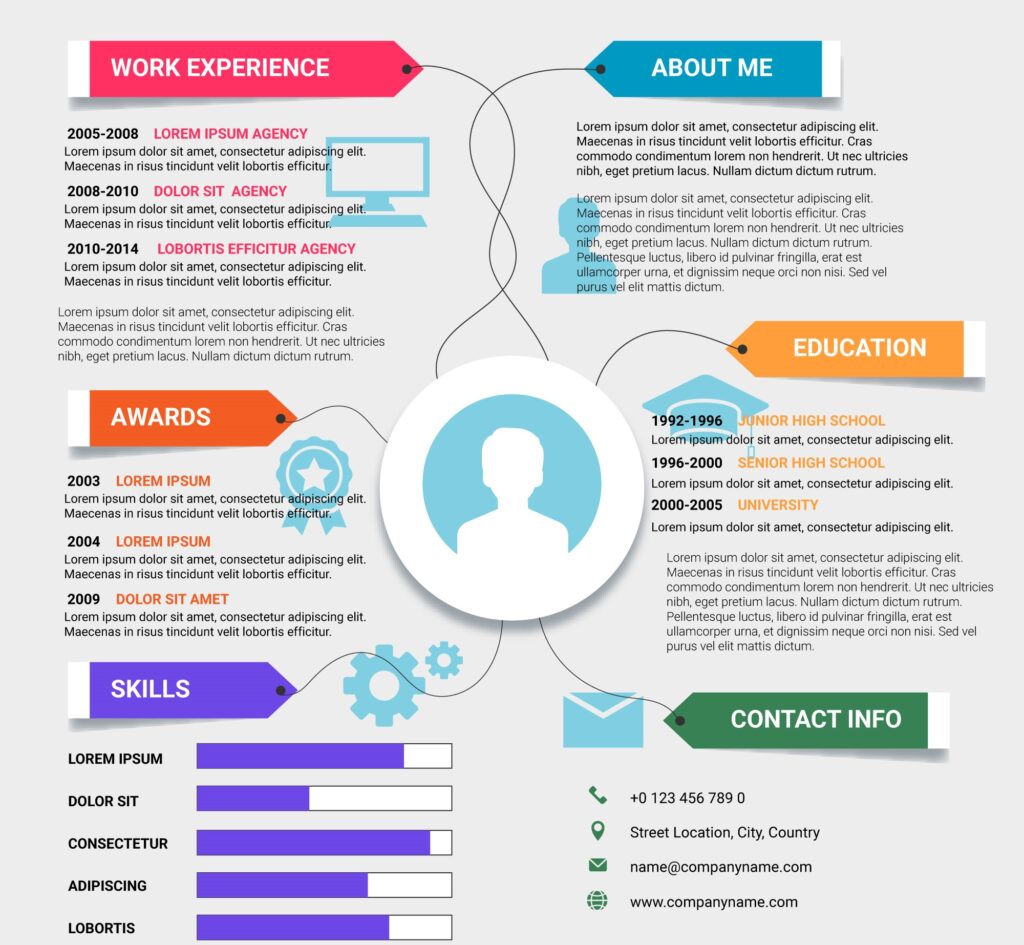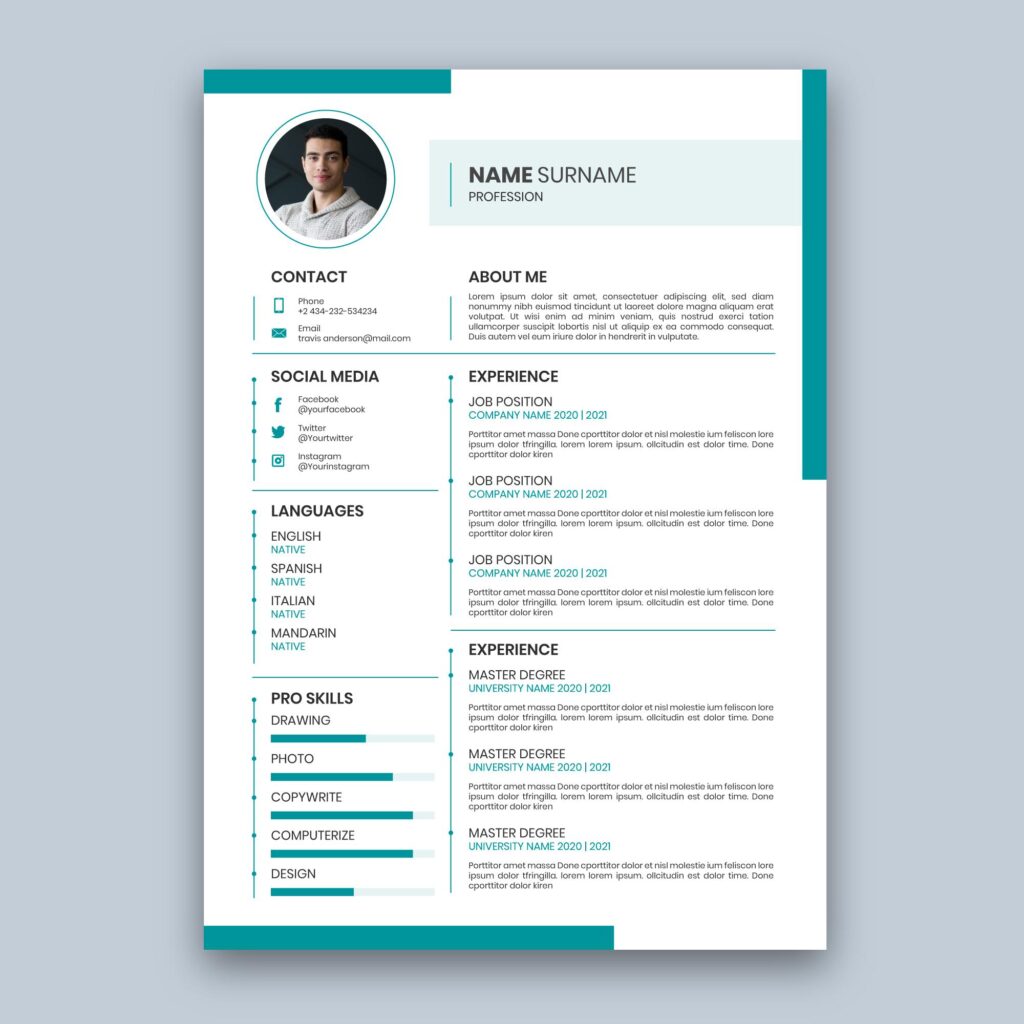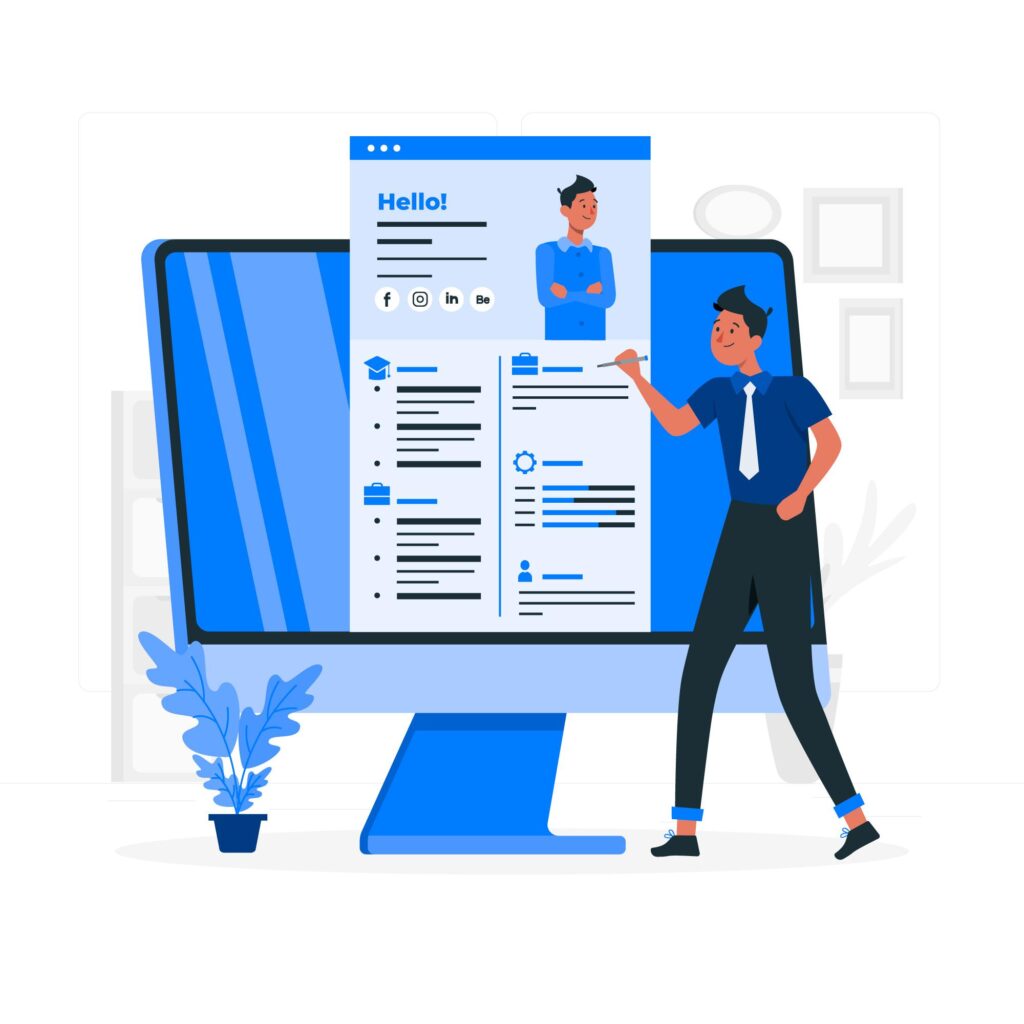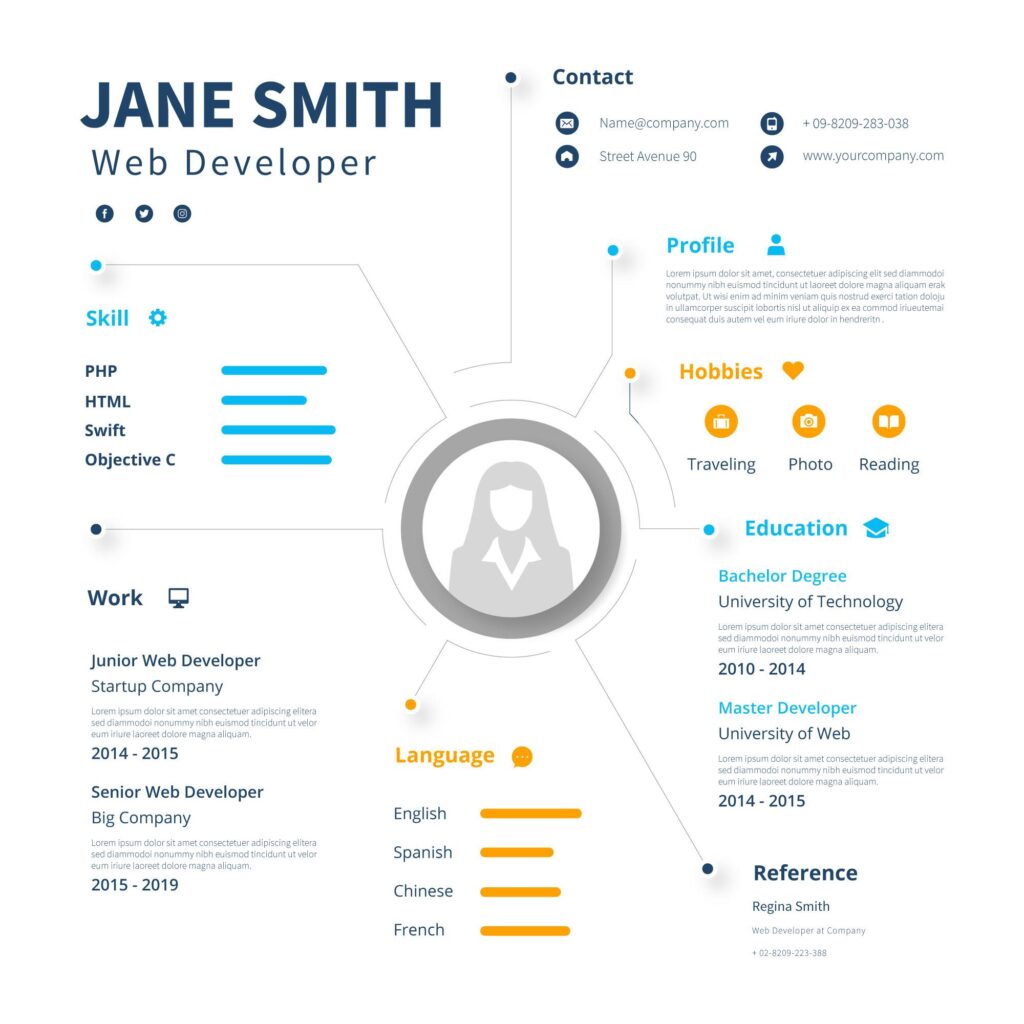Introduction:
How to Create an Impressive Resume, In today’s fiercely competitive job market, a well-crafted resume transcends being a mere account of your work history—it becomes a potent personal marketing tool. This document serves as your professional introduction to potential employers and recruiters, offering a comprehensive overview of your skills, qualifications, and achievements. The significance of a meticulously crafted resume cannot be overstated, given that it often forms the initial impression you make on hiring managers. Let’s delve into why a well-written resume is crucial and how it functions as a strategic personal marketing tool.

The Importance of a Well-Designed Resume:
First Impressions Matter: Your resume serves as the initial interaction between you and a hiring manager. A polished, well-organized document immediately conveys professionalism and meticulous attention to detail.
Showcasing Your Worth: A resume is more than a chronological list of your work history; it’s an opportunity to showcase your unique value proposition. Highlight your skills, achievements, and contributions, giving hiring managers a clear picture of your potential impact.
Demonstrating Qualifications for the Job: Tailoring your resume to the specific position involves emphasizing how your skills and experience align with the job requirements. This customization increases your chances of standing out among other candidates.
Successful Applicant Tracking System (ATS): Many companies use ATS to screen resumes before reaching human eyes. An optimized resume with relevant keywords and formatting enhances the likelihood of navigating these systems and reaching decision-makers.
Reflecting Professionalism: A carefully crafted resume reflects a commitment to professionalism, signaling that you take your career seriously and are willing to invest time and effort in presenting yourself in the best light.
Resume as a Personal Marketing Tool:
Strategic Branding: Your resume is a tool for strategic self-marketing. It goes beyond listing past works; it’s about creating a narrative that positions you as the ideal candidate for the job.
Highlighting Accomplishments: Emphasize key accomplishments and quantifiable results on your resume. This not only demonstrates your skills but also provides concrete evidence of your contributions in previous roles.
Leaving a Lasting Impression: Similar to a marketing campaign aiming for a memorable brand image, your resume should leave an indelible mark. Design elements, language, and content must synergize to capture an employer’s attention.
Standing Out in a Competitive Market: In a crowded job market, your resume must stand out. It’s your opportunity to differentiate yourself and convincingly demonstrate why you’re the best fit for the job.
1. Contact Information: Ensuring Accessibility and Professionalism

One of the foundational elements of how to create an impressive resume is a clear and comprehensive contact information section. This section not only provides crucial details for contacting recruiters but also enhances the overall professionalism of your application. Here’s a breakdown of what to include and why it’s important.
a. Full Name: Start with your full name. This allows employers to easily identify you and connect your resume to other applications you have submitted.
b. Phone Number: Enter a reliable and frequently verified phone number. If unable to answer immediately, set up a professional voicemail response. A suitable phone number enables quick contact for potential interviews or meetings.
c. Email Address: Use a professional email address incorporating your name. Avoid casual or unprofessional email addresses, as they can create a negative impression. Check this email account regularly for application-related communications.
d. LinkedIn Profile (If Applicable): In today’s digital age, your LinkedIn profile can be a valuable asset. If you have one, include its URL. Ensure your profile is complete, professional, and aligns with the information on your resume. LinkedIn serves as an extension, allowing employers to delve deeper into your professional background.
e. Address (Optional): While including the city and state is common, a full home address is often optional and depends on personal preference. If applying for a remote position or in the process of moving, you can omit this information.
Ensuring Accuracy and Timeliness: Regularly check and update your contact information, especially if it changes. Outdated phone numbers and email addresses can lead to missed opportunities and negatively impact your professionalism. During your job search, ensure all contact information on your resume is up to date.
Tips for the Expert Contact Information Section:
- Use a professional email address that includes your name, avoiding nicknames or irrelevant terms.
- Optimize your LinkedIn profile with a professional photo and ensure consistency with your resume information.
- Check for typos in your contact information; precision is crucial.
- Maintain an appropriate and professional voicemail greeting.
2. Resume Format: Choosing the Right Structure for Your Success

The format of your resume is a crucial aspect that determines how your professional journey is presented. Different situations call for different structures, and understanding when to use each format is essential. Let’s explore the three primary resume formats—chronological, functional, and combination—and guide you on when to use each:
a. Chronological Resume:
- Structure:
- Lists work experience in reverse chronological order, starting with the most recent job.
- Highlights career progression and growth.
- Suitable for those with a stable and linear career path.
- When to Use:
- Ideal for Traditional Career Paths: Use a chronological format if your work history shows a clear, upward progression in responsibility and relevance to your current career objectives.
- Stable Employment History: If you have consistent and relevant work experience without significant employment gaps, this format is effective.
- Sample Template:
- [Your Name]
- [Your Contact Information]
- Professional Summary:
- [Brief summary of your career goals and qualifications.]
- Work Experience:
- [Job Title, Company, Dates]
- Responsibilities and achievements
- [Job Title, Company, Dates]
- Responsibilities and achievements
- Education:
- [Degree, Major, University, Graduation Date]
- Relevant coursework or honors
- Skills:
- [List of relevant skills]
- Certifications:
- [Certification, Issuing Organization, Date]
b. Functional Resume:
- Structure:
- Focuses on skills and qualifications rather than a chronological work history.
- Emphasizes abilities, achievements, and expertise.
- Suitable for those changing careers or with employment gaps.
- When to Use:
- Career Change: If you are shifting industries and want to emphasize transferable skills.
- Employment Gaps: Ideal for covering gaps in employment by showcasing skills and accomplishments without emphasizing when they occurred.
- Sample Template:
- [Your Name]
- [Your Contact Information]
- Professional Summary:
- [Brief summary of your skills, achievements, and career goals.]
- Skills:
- [List of key skills relevant to the job]
- Achievements:
- [Bullet points highlighting key accomplishments]
- [Bullet points highlighting key accomplishments]
- Work Experience:
- [Job Title, Company, Dates]
- Responsibilities related to the target role
- [Job Title, Company, Dates]
- Responsibilities related to the target role
- Education:
- [Degree, Major, University, Graduation Date]
- Relevant coursework or honors
c. Combination Resume:
- Structure:
- Blends the chronological and functional formats.
- Focuses on both skills and work experience.
- Suitable for those with a diverse skill set and varied work history.
- When to Use:
- Diverse Skill Set: If your skills are just as important as your work experience.
- Highlighting Achievements: Effective when you want to emphasize specific achievements from various roles.
- Sample Template:
- [Your Name]
- [Your Contact Information]
- Professional Summary:
- [Brief summary of your skills, achievements, and career goals.]
- Skills:
- [List of key skills relevant to the job]
- Work Experience:
- [Job Title, Company, Dates]
- Responsibilities and achievements
- [Job Title, Company, Dates]
- Responsibilities and achievements
- Education:
- [Degree, Major, University, Graduation Date]
- Relevant coursework or honors
Choosing the Right Format:
- Consider Your Career Path: Choose a format that aligns with your career history and goals.
- Highlight Strengths: Use a format that showcases your strengths and minimizes weaknesses.
- Tailor to the Job: Customize your resume format based on the specific requirements of the job you’re applying for.
3. Resume Sections: Essential Components for a Comprehensive Resume
A well-structured resume comprises key sections that collectively showcase your qualifications, skills, and experiences. Here’s a breakdown of essential resume sections along with tips on what to include in each:

a. Objective/Summary:
- Purpose:
- Provide a brief introduction to your professional identity and career goals.
- Capture the reader’s attention and set the tone for the rest of the resume.
- Tips:
- Customization: Tailor this section to match the specific job you’re applying for.
- Clarity: Clearly communicate what you bring to the table and how you align with the job requirements.
- Example:
- Objective:
- Dynamic and results-driven marketing professional with a proven track record of executing successful digital campaigns. Seeking a challenging role as a Digital Marketing Specialist where creativity and strategic thinking can drive brand growth and engagement.
- Summary:
- Accomplished project manager with a background in IT and a demonstrated ability to lead cross-functional teams. Currently seeking a Project Management position where strong organizational skills and a commitment to delivering high-quality results can contribute to project success.
b. Work Experience:
- Purpose:
- Detail your professional journey, emphasizing responsibilities, achievements, and contributions.
- Showcase your growth and impact in previous roles.
- Tips:
- Relevance: Prioritize experiences that are directly relevant to the job you’re applying for.
- Quantify Achievements: Use numbers to quantify your accomplishments for added impact.
- Example:
- Work Experience:
- Digital Marketing Manager
- ABC Company, City, State | MM/YYYY – Present
- Led a team in executing digital campaigns, resulting in a 25% increase in online engagement.
- Managed social media accounts, growing followers by 30% in six months.
c. Education:
- Purpose:
- Highlight your educational background, including degrees, majors, and relevant academic achievements.
- Provide context for your qualifications.
- Tips:
- Formatting: List your most recent or relevant education first.
- Include Relevant Details: Mention honors, relevant coursework, or special projects.
- Example:
- Education:
- Bachelor of Science in Computer Science
- University Name, City, State | Graduation Date
- Relevant coursework: Software Development, Database Management
- Dean’s List, [Specific Semester]
d. Skills:
- Purpose:
- Showcase your key skills and competencies relevant to the job.
- Provide a quick overview of what you bring to the table.
- Tips:
- Tailor to the Job: Customize this section based on the skills mentioned in the job description.
- Prioritize: List the most important and relevant skills first.
- Example:
Skills:
- Social Media Management
- SEO Optimization
- Data Analysis (Google Analytics, Excel)
- Content Creation (Adobe Creative Suite)
- Team Leadership
e. Additional Sections (if needed):
- Purpose:
- Include sections that add depth to your resume, such as Certifications, Projects, Volunteer Work, or Languages.
- Highlight additional experiences or skills that are relevant to the job.
- Tips:
- Relevance: Only include additional sections that enhance your candidacy for the specific role.
- Details: Provide details that showcase your impact and contributions.
- Example:
Certifications:
- Project Management Professional (PMP)
- Google Ads Certification
Projects:
- Led a team in implementing a new CRM system, resulting in a 20% increase in efficiency.
4. Objective/Summary Statement: Crafting a Targeted Professional Introduction
The objective or summary statement is a critical component of your resume, serving as the first glimpse into your professional identity and aspirations. Crafting a compelling statement is crucial for capturing the attention of employers. Here’s a guide on how to create an effective objective or summary, emphasizing the importance of tailoring it to the specific job applied for:
1. Understand the Purpose:
- The objective or summary is your opportunity to provide a brief overview of your career goals, professional identity, and the value you bring to potential employers.
- It sets the tone for the rest of your resume and serves as a quick introduction to your qualifications.
2. Tailor to the Job:
- Customize your objective or summary for each job application. Align it with the specific requirements and expectations outlined in the job description.
- Use keywords from the job posting to demonstrate your relevance and show that you’ve thoroughly researched the role.
3. Highlight Key Skills and Experience:
- Mention your key skills, expertise, and experiences that directly relate to the position.
- Focus on what sets you apart from other candidates and why you are an ideal fit for the role.
4. Express Enthusiasm:
- Convey genuine enthusiasm for the role and the company. Employers are more likely to be interested in candidates who are excited about the opportunity.
- Use positive language to express your passion for the industry and your commitment to contributing to the success of the organization.
5. Be Concise and Clear:
- Keep the objective or summary statement concise and to the point. Avoid unnecessary details or generic statements.
- Aim for clarity, ensuring that readers can quickly grasp your professional identity and goals.
Example Template:
Objective:
[Your Profession] with [X years of experience] in [Key Skills/Industry Focus]. Proven track record of [Key Achievement or Responsibility]. Seeking a [Target Position] at [Company Name] to leverage expertise in [Relevant Skills/Industry Focus] and contribute to [Company’s Goal or Objective].
Summary:
[Adjective] and [Adjective] [Your Profession] with a background in [Your Industry]. Recognized for [Key Strength or Achievement] and adept at [Key Skill]. Excited to bring my [X years of experience] to [Company Name] in the role of [Target Position], where I can [Contribution or Goal].
7. Revisit and Revise:
- Regularly revisit and revise your objective or summary based on your evolving career goals and experiences.
- Ensure that it remains relevant and aligned with your current professional identity.
**8. Tailoring Tips:
- Mirror the Job Description: Use language and keywords similar to those in the job description.
- Highlight Relevant Experience: Emphasize experiences that directly align with the job requirements.
- Address Company Needs: Express how your skills and background address the specific needs of the company.
5. Work Experience: Showcasing Achievements with the STAR Method
Effectively communicating your accomplishments in the work experience section of your resume is crucial for making a strong impact on potential employers. The STAR (Situation, Task, Action, Result) method is a structured approach that helps you articulate your achievements in a compelling manner. Here’s how to use the STAR method and additional tips for creating impactful bullet points:

1. Situation:
- Define the context or challenge you faced.
- Provide a brief overview of the situation or problem that existed in the workplace.
- Example:
- “Faced with declining customer satisfaction scores and increased churn rates…”
2. Task:
- Specify your responsibilities and the task at hand.
- Clearly outline what your role was in addressing the situation.
- Example:
- “Tasked with improving customer satisfaction and reducing churn through targeted initiatives…”
3. Action:
- Detail the actions you took to address the situation or task.
- Use action verbs to describe your efforts, skills, and strategies.
- Example:
- “Implemented a comprehensive customer feedback program, conducted in-depth analysis of pain points, and collaborated with cross-functional teams to develop and execute improvement strategies…”
4. Result:
- Quantify the outcome of your actions and highlight the impact.
- Use metrics and percentages to demonstrate the positive results achieved.
- Example:
- “Resulted in a 20% increase in customer satisfaction scores and a 15% reduction in churn, leading to improved customer loyalty and retention.”
Tips for Crafting Effective Bullet Points:
- Use Action Verbs:
- Begin each bullet point with a strong action verb to convey a sense of purpose and accomplishment. For example, “Led,” “Developed,” “Implemented,” “Achieved,” etc.
- Quantify Achievements:
- Whenever possible, include numbers, percentages, or specific metrics to quantify your achievements. This adds credibility and provides a tangible measure of success.
- Example:
- “Increased sales revenue by 25% in the first quarter…”
- Focus on Impact:
- Emphasize the positive impact of your actions on the organization. Highlight how your contributions made a difference.
- Example:
- “Streamlined internal processes, resulting in a 30% reduction in project delivery time and improved overall team efficiency.”
- Tailor to Job Requirements:
- Customize your bullet points to align with the specific requirements of the job you’re applying for. Highlight experiences that demonstrate your suitability for the position.
- Example:
- “Developed and executed a targeted marketing campaign that resulted in a 40% increase in lead generation, exceeding quarterly sales targets.”
- Showcase Diverse Skills:
- Use your bullet points to showcase a variety of skills, including leadership, problem-solving, teamwork, and innovation.
- Example:
- “Led a cross-functional team to successfully implement a new project management system, resulting in improved collaboration and a 25% reduction in project delays.”
6. Education: Effectively Presenting Your Academic Qualifications
Your education section is a crucial part of your resume, providing insight into your academic background and qualifications. Here are guidelines on how to present your educational information effectively:

1. Formatting:
- List your educational qualifications in reverse chronological order, starting with the most recent.
- Include the name of the degree, major, the name of the institution, and the graduation date.
- Example:
Education:
Master of Business Administration (MBA)
XYZ University, City, State | Graduation Date
Bachelor of Science in Computer Science
ABC College, City, State | Graduation Date
2. Include Relevant Coursework or Projects:
- If you are a recent graduate or if there are specific courses or projects that are directly relevant to the job you’re applying for, consider including a subsection for relevant coursework or projects.
- Example:
Relevant Coursework:
- Marketing Strategy
- Data Analysis and Visualization
- Project Management
Academic Projects:
- Developed a mobile app for [specific purpose], resulting in [positive outcome].
- Conducted in-depth research on [specific topic], presenting findings at [academic event].
3. Highlight Achievements and Honors:
- If you received academic honors or awards, include them in your education section.
- Mention any noteworthy achievements during your academic tenure.
- Example:
Education:
Bachelor of Arts in English
XYZ University, City, State | Graduation Date
- Graduated Magna Cum Laude
- Awarded [Specific Scholarship or Honor]
4. Include Certifications or Additional Qualifications:
- If you have relevant certifications or additional qualifications, consider including a subsection for these under the education section.
- Example:
Education:
Master of Science in Environmental Science
ABC University, City, State | Graduation Date
Certifications:
- Environmental Impact Assessment (EIA)
- Sustainability Management Certification
7. Skills: Showcasing a Balanced Mix of Hard and Soft Skills
Effectively presenting both hard and soft skills in your resume is essential for providing a comprehensive view of your qualifications. Here’s a guide on how to showcase these skills, emphasizing their relevance to the target job:

1. Understand the Difference:
- Hard Skills: These are specific, teachable abilities or knowledge that can be measured. Examples include data analysis, programming languages, and proficiency in certain software tools.
- Soft Skills: These are interpersonal attributes and personal qualities that enhance your interactions with others. Examples include communication, teamwork, and problem-solving.
2. Tailor to the Target Job:
- Identify the key skills mentioned in the job description. Tailor your skills section to align with the specific requirements of the job you’re applying for.
- Prioritize skills that are most relevant to the position.
3. Balanced Mix of Hard and Soft Skills:
- Aim for a balanced mix of both hard and soft skills to present a well-rounded profile. This showcases not only your technical competencies but also your ability to work effectively with others.
4. Categorize Your Skills:
- Group your skills into categories to enhance organization and readability. For example, you might have categories like “Technical Skills,” “Soft Skills,” or “Language Proficiencies.”
Example:
Skills:
Technical Skills:
- Data Analysis (Python, R)
- Project Management (Agile, Scrum)
- Web Development (HTML, CSS, JavaScript)
Soft Skills:
- Communication
- Team Collaboration
- Problem-Solving
- Leadership
6. Use Action-Oriented Language:
- When listing your skills, use action-oriented language. Instead of just stating the skill, consider how you can frame it as an action that demonstrates your proficiency.
- Example:
Skills: - Conducted in-depth data analysis using Python to derive actionable insights.- Led cross-functional teams in project management using Agile methodologies.- Collaborated with stakeholders to develop and implement effective communication strategies.
7. Relevance is Key:
- Prioritize skills that directly align with the job requirements. Focus on the abilities that make you stand out as an ideal candidate for the position.
- Example:
Skills: - Social Media Marketing- SEO Optimization- Content Creation (Adobe Creative Suite)- Data Analysis (Google Analytics, Excel)
8. Proficiency Levels (Optional):
- Optionally, you can indicate your proficiency levels for each skill. For example, you might use terms like “Intermediate,” “Advanced,” or “Fluent.”
- Example:
Language Proficiencies: - Spanish: Fluent- French: Intermediate- Mandarin: Beginner
9. Keep It Concise:
- Limit your skills section to the most relevant and impactful skills. Avoid listing too many skills to maintain focus and readability.
- Example:
Skills: - Digital Marketing Strategy- SEO Optimization - Social Media Management- Content Creation (Adobe Creative Suite)- Data Analysis (Google Analytics, Excel)
10. Soft Skills in Action:
- When describing soft skills, provide examples of situations where you demonstrated these qualities. This helps to substantiate your claims.
- Example:
Soft Skills: - Effective Communication: Presented findings from data analysis in a clear and accessible manner to non-technical stakeholders.- Team Collaboration: Worked seamlessly with cross-functional teams toimplement a successful marketing campaign.
8. Formatting Tips: Creating a Clean and Professional Resume Appearance
A well-formatted resume is crucial for making a positive first impression. Follow these tips for a clean and professional appearance:

Font Choices:
- Use professional and easily readable fonts, such as Arial, Calibri, or Times New Roman.
- Maintain consistency in font size throughout the document, using 10-12 points for the main text.
Spacing:
- Ensure proper spacing between sections to improve readability.
- Use 1-inch margins to frame your resume.
Overall Layout:
- Organize your resume with clear and distinct sections (e.g., Contact Information, Objective/Summary, Work Experience, Education, Skills).
- Create a header with your name and contact details for easy identification.
Consistency:
- Maintain consistent formatting in terms of font, spacing, and alignment.
- Keep bullet points and indentation consistent for a polished look.
9. Proofreading and Editing: Ensuring Accuracy and Consistency

Proofreading is a crucial step to ensure your resume is error-free and maintains a professional tone. Consider the following:
Significance of Proofreading:
- Grammatical errors can detract from your professionalism. Proofreading ensures clarity and correctness.
- Consistency in formatting and language enhances the overall polish of your resume.
Tools and Techniques:
- Use proofreading tools like Grammarly or Microsoft Word’s spell check.
- Read your resume aloud to catch errors that may be overlooked when reading silently.
- Have someone else review your resume for a fresh perspective.
10. Customization for Job Applications: Tailoring Your Resume

Customizing your resume for each job application is crucial to stand out. Here’s how to tailor your resume effectively:
Need for Customization:
- Employers appreciate candidates who demonstrate a clear alignment with the specific job requirements.
- Customization increases the relevance of your resume, making you a more appealing candidate.
Examples:
- Job Requirement: Strong Project Management Skills
Resume:Highlighted project management experience and achievements.- Job Requirement: Expertise in Data Analysis
Resume:Emphasized data analysis skills and relevant accomplishments.
11. Visual Elements: Strategic Use for Enhanced Readability

Visual elements can improve the readability of your resume. Use them judiciously:
Bolding, Italics, and Bullet Points:
- Use bolding for section headings and key achievements.
- Italics can be used for emphasis, such as highlighting specific skills.
- Bullet points create a clear and organized structure, making information easy to scan.
Warning Against Excessive Graphics:
- Limit the use of graphics or images. Most Applicant Tracking Systems (ATS) may not process them well.
- Maintain a balance to ensure a professional and clean look.
12. Final Checks: Preparing for Submission

Before submitting your resume, conduct final checks to ensure it meets high standards:
Final Checklist:
- Proofread: Check for grammatical errors and ensure consistency in language.
- Formatting: Verify consistent font choices, spacing, and overall layout.
- Tailoring: Confirm that your resume is customized for the specific job application.
- Visual Elements: Check the strategic use of bolding, italics, and bullet points.
- File Format: Save and submit your resume in a universally accepted format, such as PDF.
Save and Submit:
- Save your resume with a professional file name (e.g., FirstName_LastName_Resume.pdf).
- When submitting online, follow the application instructions regarding file format.
Conclusion:
In conclusion, crafting an effective resume is more than a mere formality—it is your ticket to standing out in the competitive job market. As we’ve explored, a well-designed resume serves as a powerful personal marketing tool, making a lasting impression on potential employers and recruiters.

Key points to remember include the importance of a clear and comprehensive contact information section, ensuring accessibility and professionalism. This section acts as the gateway for recruiters to reach out to you promptly, emphasizing the need for accuracy and regular updates.
Additionally, the choice of resume format plays a crucial role in presenting your work history. Whether opting for a chronological structure to showcase career progression or a functional format to highlight skills and qualifications, understanding the appropriate format for your situation is essential.
As you embark on the journey of refining your resume, consider optimizing your LinkedIn profile and utilizing expert tips for creating a standout contact information section. Remember to check for typos, maintain a professional voicemail, and leave no room for outdated information.
Now is the time to take action. Your resume is not just a document; it’s a dynamic representation of your professional identity. Update your contact information, tailor your resume format to suit your career trajectory, and harness the power of strategic branding.
In a world where first impressions matter, your resume is your introduction to countless opportunities. Empower yourself by investing in a resume that reflects your professionalism, achievements, and unique value proposition. Take the first step towards career success—refine your resume and let your professional story shine.
Your future career endeavors await; seize the opportunity to make a compelling statement through your resume. Start the journey towards an enhanced professional profile today.
You can read more about it by checking the articles below:
- 23 Resume ideas | resume design, cv …
- Entrepreneurship in College
- Easy Guide to AICTE Internship Opportunities with Apply Links 2024
- e-learning platform
- Best laptops for coding
College Samaj

Secure your dream Internship and get paid with our powerful resources tailored community to match your unique interests.




